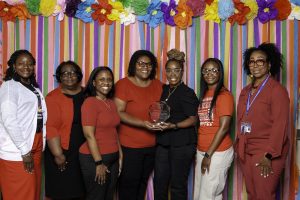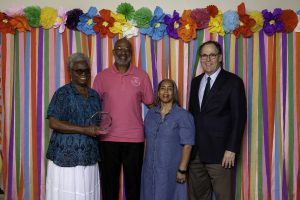By Erica D. Walker
JA Guest Writer
On Wed., Aug. 7, 2024, Community Noise Lab’s Mobile Tap Water Testing Laboratory traveled from their laboratory and office space in West Jackson to the Mississippi Delta to test the tap water of residents living in Winona, Mississippi.
“Community Noise Lab has been in Jackson, Mississippi, since 2022 offering free tap water tests for residents of the city,” says Dr. Erica Walker, a Jackson, MS native, founder of Community Noise Lab, and the RGSS Assistant Professor of Epidemiology at the Brown University School of Public Health. “It was a no-brainer for us to mobilize into action and drive to Winona to test the community’s tap water.”
Winona, Mississippi, is the county seat of Montgomery County. The town has a population of approximately 4,500 residents, of which 54% are Black and 42% are white. Close to 40% of the residents live below the poverty line. Charles Hampton, Legal Redress Chair for Winston County NAACP, attended a recent community meeting in Winona and was alarmed by the water issues residents were reporting. Hampton reports, “Water has been an issue in Winona for years. Starting in December 2023, the water crisis became unbearable for residents. The water is brown and looks unclean. Residents have resorted to using bottled water to cook, drink, and bathe. However, for many, buying this amount of bottled water is unsustainable. People have resorted to straining and boiling their tap water, but they still feel that it is unsafe despite the town’s recent efforts to repair the water system.”
After the community meeting, Mr. Hampton called Community Noise Lab.
Early on the morning of Aug. 7, Dr. Cristina Nica, Lead Research Scientist at Community Noise Lab, loaded up her car with water testing supplies and instruments, extra water testing kits, and three of her most trusted high school student summer interns – Briana Drake, a rising senior at The Piney Woods School; and Arthur Gauthier and Pranav Reddy, rising seniors at Saint Andrew’s Episcopal School – and headed north. The event took place at Zion Baptist Association in Winona.
According to Dr. Nica, the Winona community was ready for them. “There were chairs and tables already set up,” says Dr. Nica. “As soon as we arrived, we went to work immediately.” Community Noise Lab’s mobile tap water testing laboratory tested the tap water from 24 Winona households. They tested for dissolved oxygen, pH, and turbidity. The team took samples back to their laboratory in West Jackson, where trained high school students, under the supervision of Dr. Nica, will further analyze the water samples for the presence of heavy metals like lead and arsenic.
Dr. Walker will work with Dr. Kurt Pennell, the 250th Anniversary Professor of Engineering at Brown University, to test these samples for per- and polyfluoroalkyl substances (PFAS). In August 2023, Consumer Reports tested 149 drinking municipal and well water samples across Mississippi. Nearly a third of them exceeded EPAs health advisory for PFOA in drinking water and almost half exceeded the health advisor for PFOS.
After dropping off the students later that evening, Dr. Nica went home immediately and analyzed their findings in SPSS, a statistical software package, emailing Dr. Walker at midnight.
Dissolved oxygen levels ranged from 7 to 15 mg/L, with an average of 12 mg/L. Of the 24 samples tested, 92% had dissolved oxygen levels higher than the recommended concentration of 6.5-8 mg/L. For pH, samples ranged from 7 to 8, all were within recommended levels. For turbidity, samples ranged from 0 to 18 NTU, with 50% of the samples tested having levels higher than the recommended 1 NTU. For lead, there was no presence of lead in any of the tap water samples tested. The lab expects to have PFAS results in early fall. Summarized reports of all of Community Noise Lab’s tap water tests can be found on their website at communitynoiselab.org.
Student intern Drake further tested the tap water and noticed that a few of the samples had high amounts of sediment and particles in them.
“What’s in Winona’s water?” questions Dr. Walker. The turbidity levels, which measure a water’s cloudiness, are off the charts. These are levels that we haven’t seen even in Jackson.
Dr. Walker shares with the Jackson Advocate that she hopes that someone from either the Mississippi Department of Environmental Quality or Environmental Protection Agency makes testing the tap water in this community a priority.






